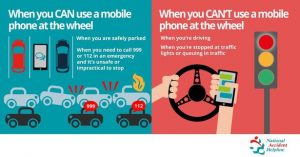Four digital PR campaign ideas that will gain coverage, links and engagement
Coming up with new ideas for digital PR campaigns can seem like a mind-boggling task. How do I create something that other people will really want to share, engage with and link to online?
These four fail-safe digital PR ideas are an excellent starting point for any successful campaign.
1. Make important information easier to digest
When the penalty for using a mobile phone while driving increased in 2017, government advice on when it was legal or illegal to use your phone while driving was available, but the details came across as dry and hard to remember. Working with a designer, we created an image for a client which made this information a lot easier to digest. This digital PR campaign generated 37 pieces of authoritative news coverage, including an article published by ITV.

2. Identify upcoming events and prepare relevant content
In the example above, it was vital to have the infographic ready to share with journalists, immediately before the law was updated. This meant having the foresight to ask the DfT when exactly the law was going to change, and planning far enough ahead to have everything signed off and ready to go in advance of that date. A simpler version of this process is using an awareness day calendar to prepare relevant content for specific, predictable events. Look for awareness days which are somehow relevant to your company so the campaign makes sense for readers. Other predictable events you can build digital PR campaigns around include seasonal changes and national holidays.
3. Carry out surveys or collect and share data from your own company
One of the best ways to generate a good, shareable headline is with fresh data. If you have the budget, commission a full survey on a topic which is a. relevant to your company and b. trending or otherwise of interest to people. Even better if you can get hold of statistically significant, regional data and generate an online, interactive map. If you're on a strict budget, cheap ways to carry out a survey include promoted Twitter polls and one question Google Surveys. Another cheap way to get hold of headline-grabbing data is to use information your company already has access to. For example, perhaps there was an increase in specific types of enquiries following Brexit, or your customers began buying a particular product during a heatwave. If you're able to put a fresh perspective on something that's relatable to the general public, journalists will be interested.
4. National competitions
Branded competitions are a genius way to get media coverage for your business. While journalists can be reluctant to put a brand in the spotlight for its own sake, they're much more happy to share news of a local person who's won an award or is shortlisted in a national competition. Photo competitions can work particularly well for digital PR campaigns, as journalists are always keen to use great images to illustrate a story. Remember to share shortlisted entries while the competition is still running, and to include a link back to an onsite entry form - we've generated hundreds of authoritative links and pieces of coverage this way.
How to create win-win relationships with journalists

Journalists can come across as abrupt, or even rude, to PR people and companies seeking publicity for their campaigns. Often, a business will take a huge amount of time and effort to put together a pitch, only to receive a 'no thanks', or even no response at all, from the journalist.
Here's what many of these companies don't realise:
- Journalists are receiving huge numbers of pitches. Sometimes these can amount to hundreds, even thousands of pitches every day, almost none of which are usable for their publications
- In an era where newspapers are often down to skeleton staff, but still have the same amount of space to fill, most journalists are under huge pressure to hit deadlines in a short space of time
The flip side to this situation is that, where a company can actually make a journalist's life easier, the business will reap rewards, with great coverage and ongoing, win-win relationships. But how can companies achieve this?
Here are five ways to improve your relationships with journalists:
- Think of a strong news angle and make that angle clear from the start. If the main point of your story is hidden half way down the email, it doesn't matter how good that angle is, the journalist will never see it. They'll be put off immediately off by the weak headline
- Write your press release in the third person. This will make it easier for a journalist to use your story as it will have been written in the way it needs to be published
- Remove anything obviously promotional from your pitches. Your press release and other media needs to come across as designed for the benefit of the publication's readers, or journalists will instantly press 'delete'
- Include quotes. A story without direct quotes lacks substance, so make sure you've included at least one quote from a person who can speak authoritatively about the story you're telling
- Include high quality imagery with your pitch. Pictures can make or break a story and, for print, journalists can scale those photos up or down. This means they can easily use exactly the right amount of space
If you'd like to learn more about how to deal with journalists, sign up for one of our upcoming Coverage Class events.
Five reasons to create content beyond your business
I recently wrote an article for award-winning digital marketing agency atom42 on five reasons you should create content beyond the immediate scope of your business. I think it's a great idea to do this - the five reasons I list are:
1. YOU’LL REACH A BIGGER AUDIENCE
2. YOU’LL GENERATE OPPORTUNITIES FOR CONSUMER INTERACTION
3. YOU’RE MORE LIKELY TO GET LINKS
4. YOU’LL CREATE BRAND AFFINITY
5. YOU’LL STAY INTERESTED
You can read the full story here.
Do you create content for your business? Do you have a content strategy which helps you decide what to write? let us know!






